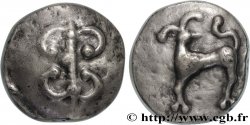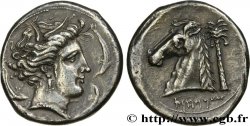v15_1375 - HELVETII (Currently Switzerland) Potin du “type de Zürich”
MONNAIES 15 (2002)
Starting price : 145.00 €
Estimate : 400.00 €
Realised price : 275.00 €
Number of bids : 4
Maximum bid : 473.00 €
Starting price : 145.00 €
Estimate : 400.00 €
Realised price : 275.00 €
Number of bids : 4
Maximum bid : 473.00 €
Type : Potin du “type de Zürich”
Date: c. 100-80 AC.
Metal : potin
Diameter : 19 mm
Weight : 3,88 g.
Rarity : R2
Coments on the condition:
Revers particulièrement beau avec l'animal en fort relief. Droit assez plat, mal venu à la coulée. Patine verte
Catalogue references :
LT.9361 - BN.9361-9363 - ABT.531 p. 514 - PK.182 - Sch/L.- - Sch/D.387 - Sch/SM.- - Z.905-919 - BMCC.S377
Obverse
Obverse legend : ANÉPIGRAPHE.
Obverse description : Axe de symétrie vertical, orné de quatre demi-cercles aux extrémités bouletées.
Reverse
Reverse legend : ANÉPIGRAPHE.
Reverse description : Bouquetin (?) à gauche, retournant la tête. La queue en esse au-dessus du dos, deux cornes aux extrémités bouletées, et sabots refendus. L’animal est vu de profil avec deux pattes mais deux sabots.
Commentary
Si nous sommes partisans de remplacer l’appellation de certains potins dits “au rameau” en potin à l’umbo, il est intéressant de rappeler la description du droit de ce potin dans le Muret Chabouillet ; “Umbo de bouclier”.








 Report a mistake
Report a mistake Print the page
Print the page Share my selection
Share my selection Ask a question
Ask a question Consign / sell
Consign / sell
 Full data
Full data















